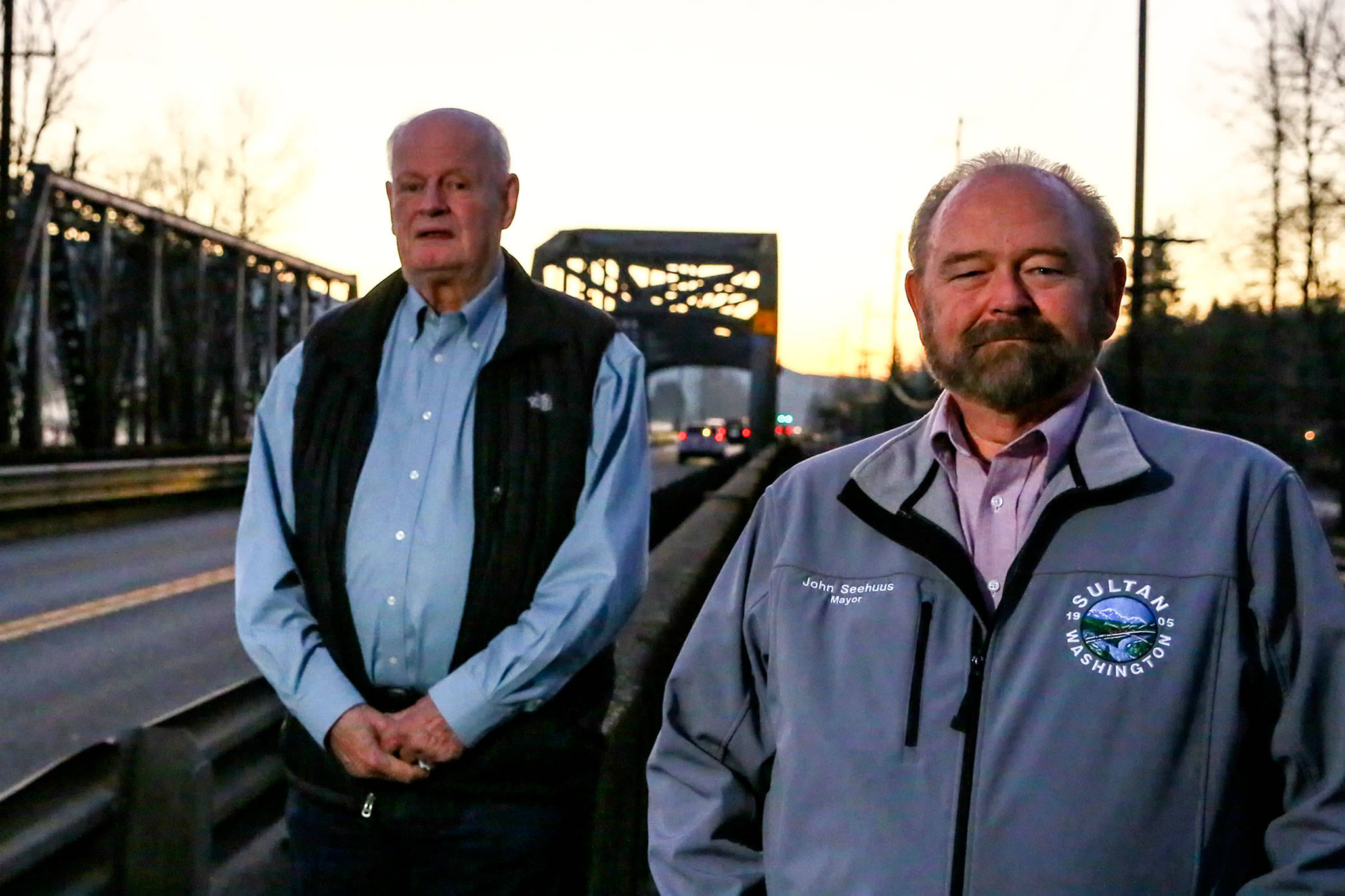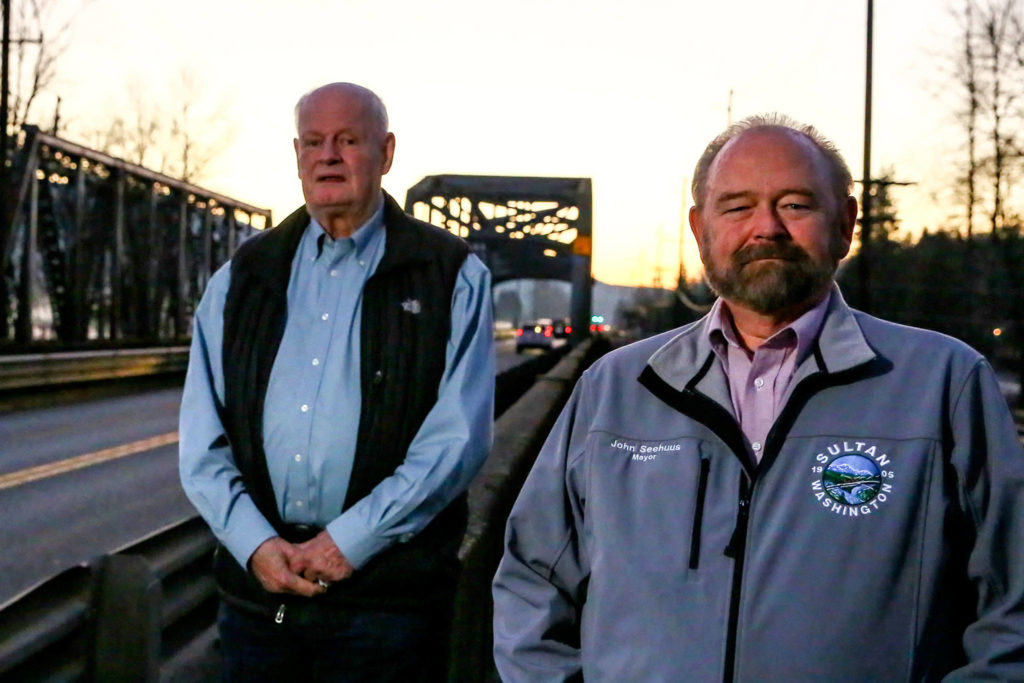SULTAN — Come midday most Sundays, Dolly Green and her husband retreat home as the onslaught of cars begins to clog U.S. 2 heading west as the weekend comes to a close.
It’s not unusual for bumper-to-bumper traffic on the two-lane to stretch from east of Gold Bar to the western edge of Sultan.
“We’re home by noon and stay there until Monday,” said Green, who has lived in Sultan for many years.
The procession of cars through the town of 5,000 peaks in the summer months, during the ski season and following a big event in the tourist town of Leavenworth. Cars slowly roll along the Stevens Pass Greenway Scenic Byway, a key recreational route between Puget Sound and the Cascades, in a hurry to make it through Sultan’s one roundabout and three traffic lights.
On Sunday afternoons, the number of cars can more than double along the corridor that links Skykomish and Sultan compared to weekday volumes, according to state Department of Transportation data. A similar trend is also building Friday afternoons.
“Basically, the residents here in Sky Valley are held hostage,” said Sam Low, the Snohomish County councilmember who represents the area.
The weekend traffic spike on the highway has been an issue for more than two decades. In recent years, gridlock has begun to overflow onto residential streets as drivers follow a shortcut offered up by Google Maps.
“Cars come flying down the road,” said Green, who lives along one of the suggested bypasses.
Then, after a few miles, drivers must rejoin the congestion but have to wait their turn to get back onto U.S. 2. It’s difficult for residents to even get to the homes of family and friends on the same road.
Drivers take an eight-mile bypass to avoid a three-mile backup to save two minutes, Low said.
Residents are organizing to free themselves as well as weekend travelers from the gridlock. State Rep. Carolyn Eslick, R-Sultan, who took office in 2017 and has endured the congestion for years, has made it one of her top priorities, as have mayors along the corridor.
Sultan’s spine
U.S. 2 starts on the eastern edge of Everett, crossing the Snohomish River as a four-lane road. On clear days, the Cascade Range beckons as the road wanders through groves of evergreen trees and farm fields. Around Monroe it officially becomes the Stevens Pass Greenway Scenic Byway and again narrows to two lanes as it leaves the city. Then the U.S. 2 meanders through the Sky Valley’s small towns, skirting the Skykomish River at times.
“This highway is our spine,” said Merlin Halverson, Sultan’s fire chief. “There are places only reachable by Highway 2.”
On Sundays, Halverson’s commute time to the station can quadruple.
“It’s solid bumper to bumper,” he said.
On those gridlocked days, it wasn’t unusual for Sultan’s outgoing mayor, John Seehuus, to receive emails from drivers stuck in the weekend slog home.
“‘Once again sitting in a Sultan-caused traffic jam,’” he recalled one note reading.
Drivers get cranky and blame the community, said Debbie Copple, executive director of the Sky Valley Chamber of Commerce.
“Sunday is not a good day for our businesses, because drivers don’t want to lose their place in line,” she said. “Half of Seattle is crammed into the scenic highway. It was never meant for that kind of capacity.
“It’s not our fault it’s way over capacity,” Copple added.
Drivers passing through often blame the bottlenecks on the town’s traffic lights.
If there were no signals in Sultan, however, there would be a continuous line of cars during peak periods and it would be very difficult and risky to turn onto U.S. 2 or get across, said Miguel Gavino, WSDOT traffic engineer for the Northwest Region.
“The bottom line is there is a whole lot more drivers wanting to use the highway than the highway is designed to carry,” Gavino said.
Car volumes more than double on Sundays along U.S. 2 through the Sky Valley compared to an average weekday Monday through Thursday, according to the latest data collected in Skykomish, the location of the closest permanent traffic counter. It’s a similar story on Fridays. The traffic jams can be traced back at least to 2001.
To accommodate the heavy traffic, in 2017 WSDOT extended the time of green at Sultan traffic lights for east-west travelers to 4 minutes between the hours of 1 p.m. and 10 p.m., Friday through Sunday. (For most signals, three minutes is allocated for the entire cycle.)
“It’s hard to tell if it is making a difference, the demand is so high,” Gavino said. “I think we are allowing more cars through, but it doesn’t reduce the length of the queues.”
Rallying for a solution
For years, residents have known not to travel the roadway Fridays and Sundays, or to plan around the gridlock, said incoming Sultan Mayor Russell Wiita.
“Now it’s impacting mobility just getting out your driveway,” he said. “People are outraged.”
This has sparked a renewed push by residents and elected officials to address the issue.
A community meeting hosted by Low and Eslick in the summer drew about 100 people, many of whom described feeling held captive by the traffic.
Working off that momentum, Eslick and Low and a coalition of mayors along U.S. 2 are organizing a lobbying effort to secure $1 million for a study of possible remedies. Civic leaders and residents are planning a trip to Olympia in February to press their point with lawmakers.
Through the years, a few ideas have been floated to ease the bottleneck: a bypass around town, widening the road or installing a one-way couplet with Main Street — creating two two-lane roads.
“I don’t want anything off the table, but widening is tough,” Wiita said.
The roadway is constrained on one side by the river and railroad tracks and the other side is lined with businesses.
Adding a lane in each direction destroys the cultural integrity and history of the small towns, said Copple of the Sky Valley Chamber.
“The majority of what you see on Highway 2 would be gone,” she said. “If the buildings could stay, there would be no parking.”
A grand plan has been proposed by the U.S. 2 Safety Coalition. Fred Walser, who leads the group, said the coalition is pushing for an extensive bypass from Everett to Spokane, with three lanes in each direction, two rail lines for freight and another for high-speed passenger trains.
The $58 billion plan, envisioned as a public-private partnership, would take years to create. Many want to see a solution sooner.
“It’s impacting the entire state. It’s time for it to become an actual discussion,” Copple said.
One short-term solution seen by new Mayor Wiita is the possibility of connecting the Sultan Basin Road to the city’s downtown, giving residents access to downtown without having to get on the highway.
Eslick suggests converting traffic signals to roundabouts. Whatever the solution, funding from the state will be needed.
For decades, Peggy Tuttle has lived along or just off Sultan Basin Road. She remembers a time when few cars traveled the narrow two-lane county road.
“If you had a flat tire, you hoped someone would come by and help,” she said.
Today her road is a de facto bypass for impatient drivers. The traffic on the once-quiet road dictates Tuttle’s weekend activities.
“Everybody plans their activities around the traffic,” she said. “We can’t plan Friday night or Sunday events. We do feel like we are trapped in our own homes.”
Lizz Giordano: 425-374-4165; egiordano@heraldnet.com. Twitter: @lizzgior.
Talk to us
> Give us your news tips.
> Send us a letter to the editor.
> More Herald contact information.



























